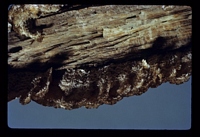|
 Stereum vellereum Stereum vellereum
SynonymsStereum sericeum
BiostatusPresent in region - Indigenous. Non endemic
Images (click to enlarge)
Caption: Pl. 23, fig. 3. Stereum vellereum, x 2/3. | 
Owner: Herb. PDD |
Article: Cunningham, G.H. (1956). Thelephoraceae of New Zealand. Part IX. The genus Stereum. Transactions of the Royal Society of New Zealand 84(2): 201-231.
Description: Hymenophore annual, coriaceous, pileate, sessile. Pilei effused-reflexed when dimidiate and
usually attached by a broad resupinate base, umbonate or cupulate when attached by a central
base, sometimes imbricate when reflexed pilei arise from a common broad resupinate base, 2-25 mm radius, and width, when laterally connate forming linear areas to 15 x 1-2 cm; pileus
surface clothed with coarse hairs usually aggregated into strigose tufts, either erect or
imbricated, concentrically zoned or not, concolorous or showing occasional bands of darker
colour, white or pallid straw colour; margin thinning out, not inturned or complicate, slightly
lobed or entire, sometimes torn when old; hymenial surface cream, pallid ochre with flesh
tints, or grey, concolorous or lighter peripherally, marked with concentric zones, or raised
lines where colonies merge, sometimes dimpled centrally and radially crenate, not creviced.
Context white or straw colour, 0.13-0.2 mm thick, a dense layer of parallel hyphae,
sometimes with an interrupted colour zone beneath surface hairs; hyphal system dimitic;
skeletal hyphae 6-8 µ diameter, lumen almost capillary, hyaline, sparsely septate, rarely
branched; generative hyphae 3-4 µ diameter, walls 0.25 µ thick, branched, septate, without
clamp connexions. Hymenial layer 30-50 µ deep, a dense palisade of basidia, paraphyses and
cystidioid hyphae. Basidia subclavate, 16-22 x 4-5 µ, 4-spored; sterigmata slender, erect, to 5
µ long. Paraphyses subcylindrical, shorter and narrower than the basidia. Cystidioid hyphae
penetrating the hymenial layer, scarcely projecting, 6-8 µ diameter, with a narrow lumen save
near the apices, contents inconspicuous; crystal masses often embedded in the subhymenium.
Spores cylindrical with rounded ends, narrowly elliptical, or suballantoid, sometimes
apiculate, 4.5-5.5 x 2.5-3 µ, walls smooth, hyaline, 0.2 µ thick.
Habitat: HABITAT. Crowded or scattered on bark or decorticated wood.
Distribution: TYPE LOCALITY. Bay of Islands, New Zealand.
DISTRIBUTION. New Zealand, Australia, Tasmania.
Notes: Although exhibiting a similar microstructure to that of S. hirsutum and S. rameale, typical
forms of S. vellereum may be separated readily. The pileus is covered with white or straw
coloured strongly developed hairs, either scrupose or imbricately arranged. The colour zone
beneath hairs is either wanting (the common condition) or scantily developed above the point
of attachment, and not visible under a hand lens. In specimens from which hairs have been
denuded the surface remains straw colour or dingy white. The context seldom exceeds 0-2
mm in thickness, consequently pilei are soft and leathery. Fructifications are either solitary,
when attached by a broad base with a prominent resupinate portion, or more often broadly
resupinate with one or two margins reflexed. They may coalesce and extend laterally, usually
on small twigs or branches, for many centimetres. At points of fusion raised lines develop, a
feature common in numerous specimens in the herbarium. The hymenial surface is usually
grey or lead colour; but not infrequently it may be tinted pallid ochre or flesh colour. Large
specimens may be separated from S. hirsutum by the different surface features, absence of a
colour zone, thinner pilei and smaller spores; small plants from S. rameale by absence of a
colour zone, usual retention of the surface hairs, absence of zones on the surface, thinner pilei
which are rarely complicate. Cystidioid hyphae are present, as in the others, but less
conspicuous since contents seldom discolour.
Although several workers have held the species to be a form of S. hirsutum, it is at least as
distinct as S. rameale is from S. hirsutum. Bresadola (1916, 232) referred the species to S.
friesii Lev., a very different plant. Judging from authentic collections examined in Kew
herbarium the species is confined to Australasia.
Article: Cooke, M.C. (1879). New Zealand fungi. Grevillea 8(46): 54-68.
|